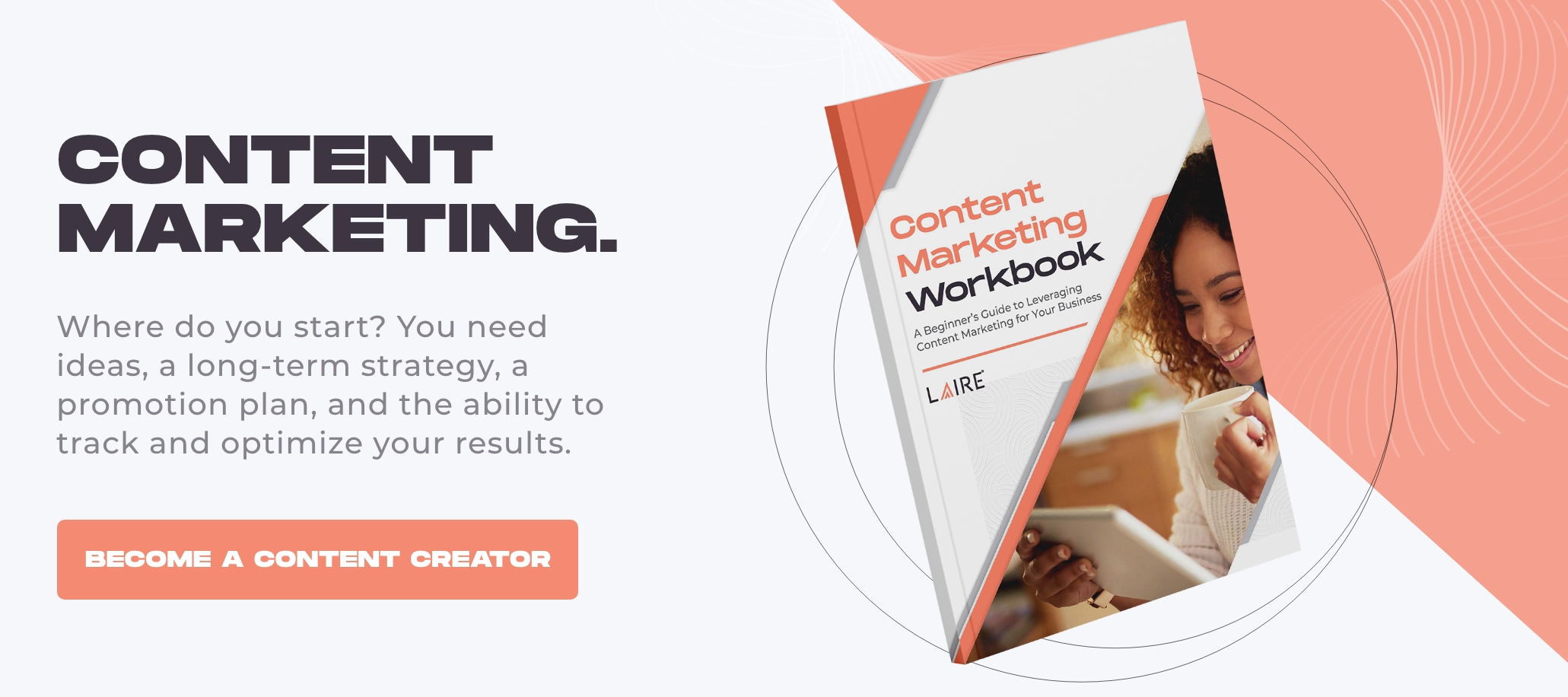Buyer-focused messaging improves content engagement and the business results you achieve from it. Buyer-focused content facilitates meaningful conversations with buyers about their pain points and goals.
A robust B2B content strategy is built around the buyer. It knows who the buyer is, what they need right NOW, and how to effectively use that messaging to increase awareness, generate leads, retain customers, and grow the business.
Let's look at how to create this kind of message!
First, Why Buyer-Focused Content?
When was the last time you Googled something related to your company?
- Why did you do it?
- What were you looking for?
- How did you phrase your search to get the most relevant websites?
- What did you do if you stumbled upon something that wasn't answering your question, was extra-promotional, had a bad website design, or lacked credibility?
- Did you care about your needs or the needs of the website you were visiting?
More often than not, this is exactly what your customers are doing when they find your website. Google processes 63,000 searches every second. And search is just one pathway they could take to find you.
Buyer-focused content centers around who this person is and why they're here right now.
It addresses a buyer’s real needs, provides answers to their problems, and then shows WHY the product/service is the perfect solution. The "what you do" matters, but it's secondary.
You're focused on the buyer—the same person the buyer is focused on. To communicate effectively, don't two people need to be focused on the same thing?
Know Your Buyers
Understanding who the buyer is is vital to generating the content engagement that B2B content marketing professionals can use to get business results. It doesn't matter what your B2B marketing KPIs are if this individual doesn't perceive value in what you have to offer.
Knowing your buyer starts with building data-informed buyer personas.
Developing a Buyer Persona
A buyer persona is a semi-fictional, data-based composite of your ideal customer. Give this fictional person a name to bring "them" to life for you and your team.
Questions to consider when building your persona:
- Who are you trying to connect with?
- What problem are they trying to solve?
- What information are they looking for?
- Where do they go for information?
Notice we didn't even touch on the solution you offer. Buyer-focused messaging ALWAYS revolves around the buyer. You'll communicate solutions at the right time, but they're secondary.
Most buyers will have a primary problem. It's the problem that most often drives them to someone with solutions like yours. To really understand who this buyer is, you need to figure out what this big problem is.
If you're unsure what the big one is because you solve so many, ask them and explore what their answers have in common.
Look for insights into who they are and what motivates them. Identify patterns in their behaviors and preferences. This allows you to effectively communicate what makes your solution different or better, tap into the right emotions, and manage objections.
Now, put yourself in this person's shoes. Use first person singular (I) to state out loud what this person's goals/problems are and how they feel about them.
Write it down this way. Give this person a face and name. Now, when you create content, you're speaking with this person one-one like you're sitting in a room together. This is how to have the perfect conversion with your ideal client.
Building a Message Around Your Buyer Persona
Think of your buyer persona as the "listening" side of a conversation. You've combined actual customer comments in surveys, reviews, social media, and interactions with more objective CRM data to understand their problems, goals, pain points, and the emotions they feel around them. You're a good listener.
As a result, your buyer-focused messaging speaks directly to those in your B2B content.
Prioritize Benefits Over Features
A feature is something your product does or is.
For example, email automation is a feature of HubSpot Marketing Hub. On the other hand, a benefit is what your buyer can expect to get out of the product. More efficient lead nurturing, higher quality leads, and higher revenues are all benefits. These are what the buyer GETS when they buy your product.
Focus on the benefits!
As a sales or marketing leader, you're familiar with this concept. But how often do we follow our own advice? When your not generating the engagement or conversions you want, it's so tempting to beef up the features to get that win.
But there are several reasons that leading with the benefits, and the value you're offering, is a better short- and long-term strategy.
- In B2B, the decision-maker is often not the end-user, so how a feature actually works may be meaningless to them.
- Over-reliance on features leads to brutal feature wars with competitors.
- Features get complex and confusing fast.
- People don't usually search for features on Google because different companies have clever names for the exact same thing. Instead, people search for problems and solutions.
- People can learn how to use features after they get a product. Before that, features are abstract.
- At the end of the day, the buyer wants to know how this benefits them, not that it has 10 times the features.
Turn Benefits Into Outcomes
We would argue that in modern B2B content marketing, your message should go beyond even the benefits. Explicitly describe the outcomes. Outcomes ARE a type of benefit. But they're focused on what the buyer really hopes to get out of this.
- Feature-focused message: We offer a state-of-the-art feature that no one else has because we call ours this clever name. And maybe it is a little better. But you have no way to compare ours to the competitors unless you buy from both. See how quickly your competitor can 1-Up you if you put features ahead of benefits in messaging!
- Benefits-focused message: Our product helps you manage line production, increase team productivity, reduce errors, and cut wasteful spending.
- Outcome-focused message: Our product delights customers and keeps them coming back, promoting faster, more sustainable business growth.
To get to the outcome-focused message, ask yourself why your buyer wants the benefits you offer. What outcome do they expect from buying? Focus on that first.
So, what's the point of more productivity? It's to delight customers and experience sustainable growth.
Consider the Buyer’s Journey
Timing is critical to ensuring that the right person gets the right message at the right time. The type of content and how you communicate your message adapts based on where the buyer is on the road to the buying decision.
If your content doesn’t provide the answers to the questions buyers have NOW, they will find answers elsewhere. And your competitor earns that lead—even if you have the better features, service, and fit for the buyer's needs. It hurts when that happens.
In B2B inbound marketing and content marketing, we call this the "buyer's journey". Like buyer-focused content, we look at it from the buyer's point of view.
- Awareness. The Buyer recognizes they have a problem and starts trying to learn more about it (often on Google)
- Consideration. The Buyer finds out about possible solutions and seeks out content that helps them learn more about them so they can narrow them down.
- Conversion/ Decision-making. They consider who offers the best solution and which of their options they'll choose.
Because you've been with them since they first learned they had a problem, you've built trust and authority, you can now effectively leverage to win this deal.
Given that a buyer moves through stages, you'll create content for each stage. Content isn't only aligned with the stage. It effectively guides the person through the journey by showing WHY it benefits the buyer to take that next step. The Value Proposition!
It's important for marketing teams to invest in content for each stage of the buyer's journey. If you try to skip a step, the person stops taking this journey with you. They head to the website next door to buy from your competitor.
Use marketing analytics to track conversions between stages. This tells you where you're losing people on the journey (a.k.a. funnel). Where do you need to improve your buyer-focused messaging?
Content in the Right Format for That Stage
Certain content formats work well at each stage because of their strengths and weakness, when the buyer is likely to see them, etc.
Awareness
- Blog posts
- Videos
- Social media posts
- Paid advertising
- Events that get people talking
What makes each of these buyer-focused content during the awareness stage? They're easily findable if you're covering the problems your buyer persona has. They don't have to go too in-depth because the buyer is just starting to scratch the surface. They're often an introduction to an idea but should also provide value.
At LAIRE, we always say, “Be helpful first”! But at the same time, they send the message that the buyer will experience more value by moving to the next stage of the buyer's journey—consideration.
Consideration
- eBooks
- Whitepapers using first-party data as much as possible
- Sales enablement content
- Email marketing
- Powerful CTAs
- Landing pages
Here, buyer-focused content discusses and compares the solutions in more depth. In B2B content strategy, you'll use a powerful CTA to encourage a visitor to download an eBook or Whitepaper. When you do, you're encouraging them to enter the next stage.
Conversion / Decision-making
- Free trials
- Webinars
- Case studies
- Demos
- Customized pricing strategies
This is where buyer-focused messaging really hits home WHY your solutions deliver the OUTCOME the buyer is looking for. You can be more straightforward in nurturing this lead because you've earned the trust of the buyer.
Your Buyers Are Tired of Reading About You!
Stop with the self-promotional content. Your customers know when they’re being sold to. What they really need is help. When you genuinely want to help people, you help first.
The job of a marketer is to educate and show them how they can become more successful without actively pitching their product or service.
Think about it for a minute!
Do you respond well to someone telling you they're the greatest thing ever, the competition sticks, and you should buy now?
We all know intuitively that today's buyers don't respond to that and don't like it. You don't like dealing with pushy sales messages any more than your customers do. Yet, many still believe the only way to meet KPIs consistently is by being promotional and pushy.
This doesn't mean you never have a CTA.
The same "buy it now" language doesn't sound pushy when your B2B content marketing uses buyer-focused messaging to build trust and offer value first.
By understanding who your buyer is and what will help them right now, you pave the way to sell to them when the time is right, and by doing so generate a higher customer lifetime value.
To learn more about how to leverage buyer-focused content to meet KPIs, download our B2B Content Marketing Workbook:

